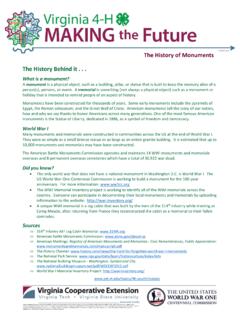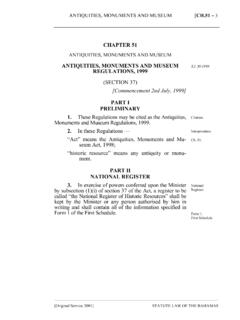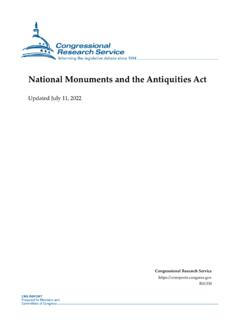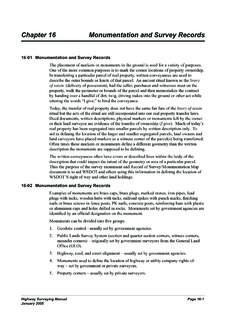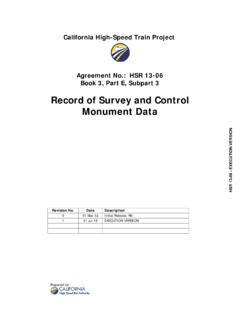Transcription of PUBLIC ART AND MONUMENTS ADVISORY COMMITTEE …
1 ADVISORY COMMITTEE Final Report as of June 30, 2018 Page 1 PUBLIC ART AND MONUMENTS ADVISORY COMMITTEE Report to the Mayor June 30, 2018 ADVISORY COMMITTEE Final Report as of June 30, 2018 Page 2 CONTENTS COMMITTEE Letter page 3 Introduction page 4 Process page 5 Findings page 6 Members page 9 ADVISORY COMMITTEE Final Report as of June 30, 2018 Page 3 PUBLIC ART AND MONUMENTS ADVISORY COMMITTEE LETTER TO THE MAYOR As appointed members of the PUBLIC Art and MONUMENTS ADVISORY COMMITTEE , we submit the following report and conclude this COMMITTEE s PUBLIC process and designated scope of work. The report presents principles and criteria derived from PUBLIC input and COMMITTEE discussion. The principles and criteria provide a guide for decisions regarding the preservation or removal of artworks and MONUMENTS in PUBLIC spaces. In keeping with the COMMITTEE s scope of work, the principles and criteria are broad and applicable to all artworks and MONUMENTS in PUBLIC spaces.
2 Through the COMMITTEE s meetings and review of PUBLIC input, we observe that the community is intensely focused on the John Breckinridge Castleman monument and that there are a wide variety of sentiments about the monument . Further, the community is eager to reach a resolution for the monument . As a COMMITTEE we did not address in our report the current controversy surrounding the John Breckinridge Castleman monument as we believe the purpose of the COMMITTEE s work is to develop principles and criteria that apply to today s controversies as well as those we have not yet encountered. With this report we have provided a foundation and as a COMMITTEE we encourage and support the Mayor in making a timely response regarding MONUMENTS that are the focus of community concern. The COMMITTEE s work has been challenging and, at times, emotionally charged. We each acknowledge a great respect for our co- COMMITTEE members and the unique, thoughtful approach that each individual contributed to the process.
3 We also acknowledge members of our community who courageously spoke up about challenging subjects, both in person and in writing. It is their contributions and expressions that form the basis of the submitted report. We urge our community to continue the work of open dialogue, not only about PUBLIC art and MONUMENTS , but about all symbols of racism and discrimination and how we as a community can move forward to advance equity, inclusivity, and healing. We appreciate that as Mayor, you allowed us to create a platform for open and honest conversation. While we know that there will not always be consensus regarding PUBLIC art and MONUMENTS in a diverse and ever-changing community, the importance of a platform for open dialogue cannot be understated. We did not take our jobs on this COMMITTEE lightly. We hope that the following report, its exploration of community values and principles, serves you well in your consideration and evaluation of Louisville s artworks and MONUMENTS in PUBLIC spaces.
4 Sincerely, _____ _____ Tricia Burke Dr. Thomas Owen _____ _____ Carolle Jones Clay Dr. Chris Reitz _____ _____ Dr. Dewey Clayton Cathy Shannon _____ Ashley Haynes ADVISORY COMMITTEE Final Report as of June 30, 2018 Page 4 INTRODUCTION The PUBLIC Art and MONUMENTS ADVISORY COMMITTEE is charged with developing a set of principles for evaluating Louisville s existing PUBLIC art and MONUMENTS . COMMITTEE members represent a range of disciplines and perspectives, including art, history, community building, business and political science. The scope of work for the COMMITTEE for February through June 2018 will include: review processes, actions and outcomes employed by other cities; develop strategies to receive PUBLIC input; work with Metro staff to gather and review historical research; consider PUBLIC opinion, historical research and the multi-disciplinary perspectives of COMMITTEE members in developing principles; and produce a report outlining the COMMITTEE s methods of inquiry and findings on the matter of establishing principles to guide decisions on whether to alter, preserve or remove PUBLIC art and MONUMENTS .
5 The set of principles that the COMMITTEE is tasked with developing will acknowledge the complexities of Louisville s past, as well as the values that matter to us today. They will be comprehensive, rather than specific to current controversies, and informed by the work of the city s Commission on PUBLIC Art, Compassionate City initiatives, and Historic Preservation ADVISORY Task Force. The COMMITTEE will consider the historical representation of our city s existing PUBLIC art and MONUMENTS and develop principles that aspire to make PUBLIC spaces welcoming and reflective of our diverse community. The principles will guide the administration s deliberation on whether to alter, to preserve or to remove PUBLIC art and MONUMENTS that may be interpreted as honoring bigotry, racism and/or slavery. ADVISORY COMMITTEE Final Report as of June 30, 2018 Page 5 PROCESS PUBLIC Meetings and Engagement to Date February 7 COMMITTEE Meeting Main Library March 6 COMMITTEE Meeting Kentucky Center for African American Heritage April 12 COMMITTEE Meeting University of Louisville Campus April 14 COMMITTEE Meeting Cyril Allgeier Community Center April 28-29 Staff Engagement Cherokee Triangle Art Fair May 18 COMMITTEE Meeting South Central Library June 5 COMMITTEE Meeting Main Library June 27 COMMITTEE Meeting Main Library PUBLIC Comments Received (approximate number received, ongoing) Online Form (~1000) Emails (~150) Postcards and post-its from engagement events (~150) Mailed letters and documents submitted during meetings (~50) #monumentalletters on social media PUBLIC meeting sign-in sheets (~ 90 emails on distribution list)
6 Web Page PUBLIC input posted online regularly COMMITTEE documents and resources posted online Links to video of each meeting ADVISORY COMMITTEE Final Report as of June 30, 2018 Page 6 FINDINGS The COMMITTEE has established two references for evaluating Louisville s PUBLIC MONUMENTS . The first is a set of principles that emerge from our discussions and our engagement with the PUBLIC . The second is a set of criteria that should be used to determine outcomes for contested MONUMENTS ( conservation, recontextualization, or removal from PUBLIC display). These criteria follow from our principles. Principles regarding Louisville s PUBLIC MONUMENTS and statues: MONUMENTS are not history. MONUMENTS are one of the ways city government can highlight select historical figures and events and make them accessible to the PUBLIC . This means that MONUMENTS in PUBLIC spaces become sanctioned versions of history. They reveal some parts of history and hide others, while imposing on us notions of who we are and where we come from.
7 However, MONUMENTS are often part of our art historical record and the city does have an obligation to preserve that record when possible, although not necessarily in a PUBLIC right-of-way or civic space. Our monument landscape reflects the history of monument making, not necessarily the full history of Louisville. This must be rectified. There have historically been a great number of reasons to build MONUMENTS . In the post-civil-war era, for example, MONUMENTS to Confederate soldiers were frequently erected as a way to perpetuate systemic racism and bigotry. This is historically significant. But we must ensure that in our lived experience MONUMENTS do not serve such purposes. Instead they should be tasked with representing a shared history to the PUBLIC . Those in positions of privilege and power have largely determined that history and the PUBLIC that it addresses. Thus the city must occasionally revisit its MONUMENTS in order to adjust our landscape and ensure that it reflects a shared vision of our history.
8 Our MONUMENTS must reflect the demographics and composition of our city as a whole. Louisville needs to align its artworks and MONUMENTS in PUBLIC spaces with the vision of our city as a progressive, compassionate, and equitable community. PUBLIC spaces must be inclusive. MONUMENTS must be accessible. This means that the city should strive to make MONUMENTS as physically and programmatically accessible as possible to all of Louisville s communities, and consider the application of Universal Design principles. It also means that they must be contextualized for the general PUBLIC in a way that is inclusive and encourages active engagement. ADVISORY COMMITTEE Final Report as of June 30, 2018 Page 7 History is complex. Some historical figures and events provoke pride. Others shame. PUBLIC interpretations of history should not shy away from the latter in favor of the former. One of the problems with MONUMENTS to historical figures is that they are not particularly well suited to nuance.
9 A bronze figure towering above a city street gives the impression that the city celebrates the entire life of the figure depicted. But no life is beyond criticism, and some of the most impactful Louisvillians (in terms of our city s landscape and institutions) are also very controversial figures. The city should not shy away from these problems. The criteria for removing a monument , as well as the criteria for installing a new monument , must be rigorous. Removing a longstanding PUBLIC fixture, no matter how contested, is a not a small matter. However, removal is the best option when it is not possible to reconcile the monument s message with the values of the city. In very rare cases, adding more nuanced historical context to challenging works may be considered as a first step. In these very rare cases, additional historical context in the form of counter MONUMENTS or other adaptations must meet the following criteria: a PUBLIC process is included in the project development comprehensive research is conducted on the original monument and made accessible to the PUBLIC additional context reveals divergent historical narratives scale and impact reflects or exceeds the original monument located appropriately so that original monument cannot be viewed without the added context Criteria for evaluation: Given the principles outlined above, contested MONUMENTS should be evaluated based on the following criteria.
10 Is the principal legacy of the subject depicted in the monument fundamentally at odds with current community values? Especially in the case of figurative sculptures, MONUMENTS should be evaluated based on the principal contribution of their subjects. Secondary and tertiary contributions may tarnish a subject s legacy, but whenever possible MONUMENTS should be evaluated based on the principal legacy of their subject and its appropriateness to contemporary community values. What was once a secondary or tertiary contribution may become a subject s principal legacy, and when that happens the monument must be reevaluated. However, community values and the principal legacy of historic figures will change with time. New facts about historic figures will come to light through research, and old facts will take on new meaning as our community evolves. ADVISORY COMMITTEE Final Report as of June 30, 2018 Page 8 Is the subject a potential rallying point for racist or bigoted groups?





